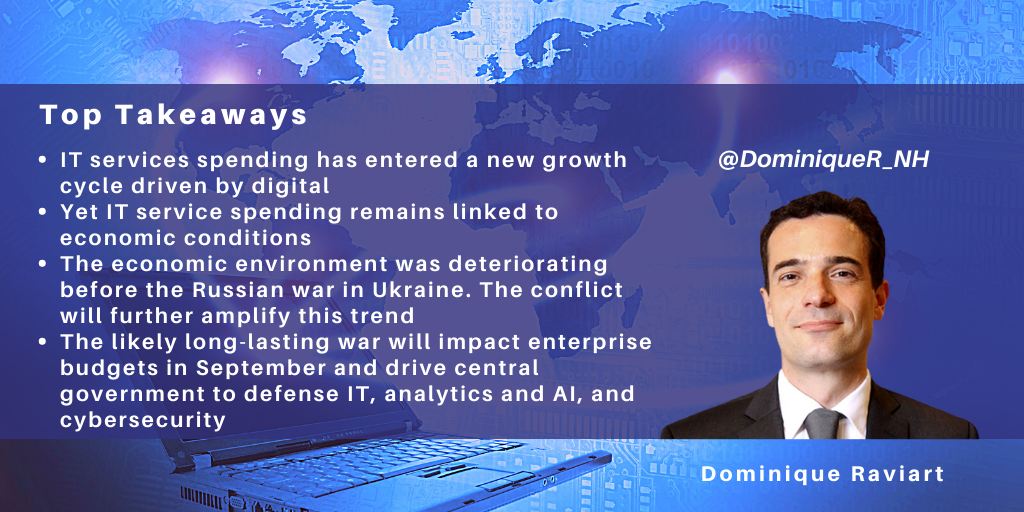posted on Apr 07, 2022 by Dominique Raviart

NelsonHall is currently updating its bi-annual IT services forecasts, and here’s a quick look at some of the headlines for 2022.
COVID-19 no longer a threat to IT services spending growth
The world has evidently changed since our November 2021 update. The pandemic now seems largely under control, despite spikes in China. India, the world’s IT services hub, is gradually opening its offices. IT services providers now have substantial experience of operating primarily in a work from home environment, as indeed have their clients. Should there be another widespread spike in cases coming from a new COVID-19 variant, delivery disruption will be minimal.
A deteriorating economic environment
IT services spending is cyclical and dependent on GDP growth expectations. The macro-economic environment has deteriorated with the February 24 Russian invasion of Ukraine, amplifying existing trends at play. In its January 2022 World Economic Outlook Update, the IMF warned, beyond COVID, of “rising energy prices and supply disruptions” leading to higher and more spread inflation globally. In January, the IMF revised down its global GDP growth estimates.
There is no doubt that the Russian invasion of Ukraine, with its impact on energy, will accelerate trends at play before the invasion. In late April, we expect the IMF to further reduce its GDP growth expectations, for both North America and Europe.
Digital drives higher spending
However, the connection between IT services spending and GDP growth has changed. In a previous blog, IT Services in 2022: Entering A New Growth Phase, we highlighted that until 2019, IT services spending typically grew around 100 bps slower than GDP growth. From 2021 onward, we expect IT services spending to grow faster than GDP growth, driven by digital, security, and cloud. IT services spending growth in 2022 will be similar to 2021, between 6% and 7%.
Prices will remain under control despite the talent shortage
The hiring effort supports our growth hypothesis. Despite the many discussions about the lack of talent in the industry, data from the top eight India-centric IT services vendors(1) show they recruited in calendar 2021 at scale. Net recruitments reached ~330k employees. This headcount increase is exceptional.
We are entering the calendar Q1 2022 financial announcement season and will be tracking net headcount growth. An early indication came from Accenture for its Q2 FY23 results (ending February 28, 2022): the company increased its headcount by 24k (vs. 28k in Q2 FY21). Hiring remains sustained.
Despite the talent shortage, vendors have the ability to scale up and wage inflation is likely to remain under control. Meanwhile, vendors continue to accelerate their use of automation and cognitive technologies to drive further efficiencies and reduce, to some extent, their dependency on recruitment.
The Russian war in Ukraine brings great uncertainty
And then of course are the uncertainty factors, and this year they center on Russia, notably the duration of Russian’s invasion of Ukraine. If the war lasts longer or expands, the IMF predictions will again lower GDP growth.
We expect two scenarios form a long-lasting conflict.
- Most enterprises set up their annual budgets in the September/October period: if the war continues (or concerns remain about new Russian conflicts in Central Europe), many large enterprises will seek to reduce their IT budgets. A significant freeze in Q4 2022 spending (and for full-year 2023) is still possible. 2022 may be a year of high spending increase in Q1-Q3 with a sharp decline in Q4. In parallel, enterprises will increase their cybersecurity funding and will delay their digital projects, should the war continue or expand
- IT services spending will shift. While it will decline for enterprises, it will increase among central governments, around defense IT, data analytics and AI, and cybersecurity.
This year will be bumpy.
(1): Accenture, TCS, Cognizant, Capgemini, Infosys, Wipro, HCL Tech, and Tech Mahindra.
